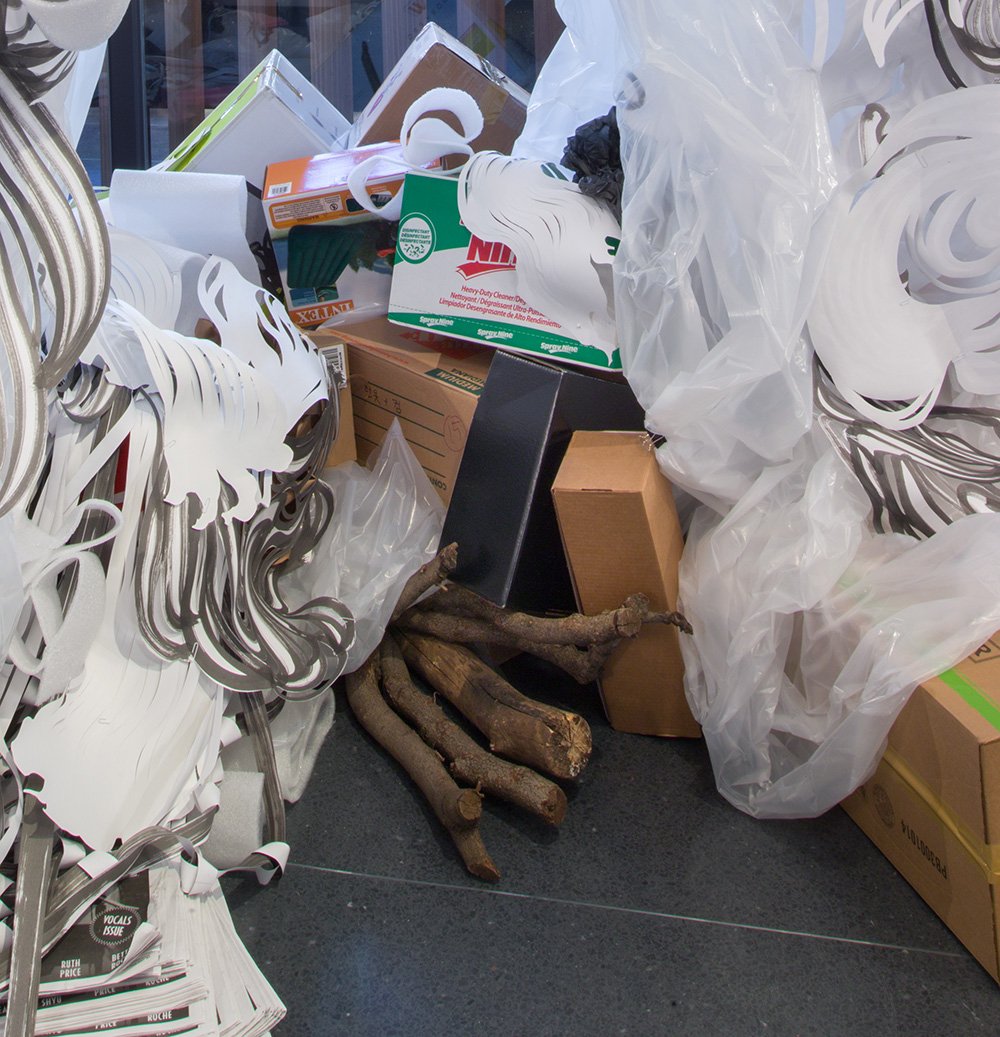ALLUVIO, 2017
ALLUVIO
2017
Paper, plastic sheeting, garbage bags, cardboard boxes, tree branches, foam, newspaper, India ink, paperclips, tacks
Dimensions variable
Brooklyn, NY
ALLUVIO refers to alluviam, deposits of sand, mud, and other material formed by flowing water. Over time, this material builds up and creates a new landscape, often at the edge of a river or other flowing body of water. Geologically, alluvial deposits can even contain precious metals like gold or silver.
I chose this idea as a metaphor for times of transition. Right now we are living through a period of enormous change, politically, socially, and environmentally. Some of these changes feel new, but are actually new versions or permutations of earlier events: the rise once again of the far right in Europe, reignited racial and ethnic polarization in the U.S., a volatile and unstable climate that is the result of human earlier choices. Every transition that is happening today brings with it the history of everything that happened up until that moment, just like water carrying bits of landscape from an earlier location to a new one.
Moving is also a time of great transition, and when we move, we bring with us our memories of every place we have lived, our hopes for our new home, and lots and lots of STUFF. Moving necessitates boxes, plastic, foam wrap, all of which is immediately discarded into a landfill or eventually makes its way into the oceans. These vestiges of the moving process don't disappear when we throw them away, they just accumulate somewhere else in a different form.
The materials I used for ALLUVIO are, other than the cut paper I made in my studio, remnants of a moving process, whether from people moving from home to home, or goods moving to people. The pink foam was discarded by my upstairs studio neighbors who moved after 20 years. The boxes are from an apartment building, reflecting both how we live today (buying so much online) and how we move (hand labeled moving boxes in different languages). The water bottles are recycling from my own studio, the branches were discarded by a neighbor on my street, and the garbage bags are the means by which we throw all of this stuff out. The plastic is the unifying element: it evokes water and also visually connects all of these disparate elements into a cohesive whole. Every single object in this installation has a specific reference to times of transition (the pruning of trees before winter, the emptying of a bottle).
As an artist who makes site specific installations, my primary inspiration is the site itself: the scale, the traffic patterns, the light---but also who occupies the space, what they might be thinking about, what experiences they may bring to the artwork. I consider all of these elements when I decide how to build my installations in order to create very specific viewpoints by using the space in different ways. In this case, it was exciting to use the floor area to build a temporary landscape that both draws you to it and keeps you out, like a rushing river filled with debris, an image we have seen nonstop these days in the wake of so many hurricanes.
This was a particularly intriguing space for me artistically because of its glass walls, the various types of lighting, the location in the lobby and in that neighborhood, which itself is in the throes of a radical transformation, of which this building is a part.
Of great interest to me was that unlike in a regular space, the artwork could be seen at every angle through the glass. So that gave me free rein to occupy the inside, knowing it could be seen from the outside as well.
The drama of the installation may provoke a visceral reaction: attraction, fear, disgust, euphoria, laughter. It's absurd that humans buy plastic makeup organizers, it's funny! At least I think so.
The world we live in right now is constantly in flux. It's messy, it's scary, it's hard to understand and almost impossible to control. I know my life is.
Paper Tigers - FB Watch Series











